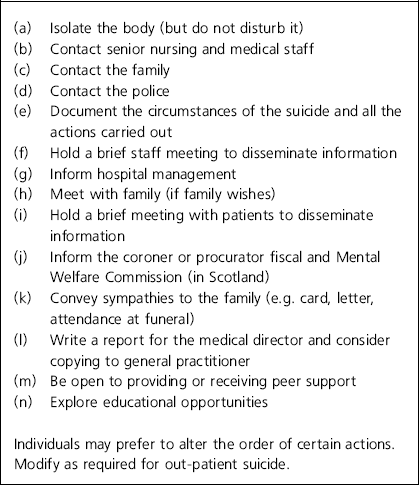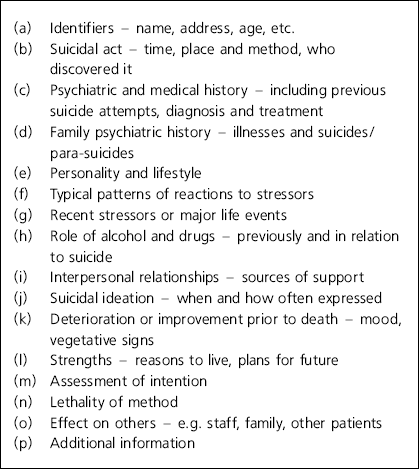A patient has committed suicide. You are his/her doctor. You're faced with the emotional impact this has on yourself, your colleagues, the patient's family and your other patients. You must report the suicide to your hospital authority and to the corner (or procurator fiscal in Scotland). If you're very unlucky, you may be the focus of media attention. You have the prospect of a coroner's (or fatal accident) inquiry, a hospital inquiry and perhaps copycat suicides or para-suicides among your other patients. What are your obligations, where do you turn for help and can anything positive come from the experience?
Attempting to answer these questions can be daunting. The suicide of a patient has many far-reaching effects. There is a paucity of literature to guide you and although devastating, it remains a comparatively rare event. Therefore developing expertise in dealing with it is difficult. This paper attempts to give pointers on what to do, based on the available literature and personal experiences.
Obligations
Obligations will vary according to where the suicide occurs. The comments that follow refer mainly to inpatient (see Box 1) or day patient suicides. Procedures can be modified for out-patient suicides, which may not immediately be known to hospital staff, and where other people have acted first.
Box 1 Checklist of actions following in-patient suicide

|
| Individuals may prefer to alter the order of certain actions. |
| Modify as required for out-patient suicide. |
Communication with people immediately affected by the suicide
The patient's family must be informed without delay, preferably by the head of the clinical team. In any case, senior team members, including the consultant, should see family members as soon as possible. They need to know what happened and may vent their feelings, which can include grief, anger and blame. The consultant should not be drawn into apportioning blame or be overly defensive. Remember that a duty of confidentiality to the patient still exists. Little (Reference Little1992) then suggests holding an initial meeting of the ward staff, followed by a staff-patient meeting. Both meetings should be for information purposes. The staff-patient meeting should give staff an opportunity to identify those patients most at risk, and patients an opportunity to voice their fears and feelings. Some may need reassurance that they remain safe. Staff should be encouraged to share their sympathies with the family, perhaps by sending a card, note or flowers, or by attending the funeral. The consultant may wish to send a letter expressing condolences, although ideally this should have been done in person. Kaye & Soreff (Reference Kaye and Soreff1991) report a favourable response from a family when Kaye attended a funeral. However, one needs to be sensitive to the wishes of the family when considering whether to attend or not. While some may draw some comfort from it, others may be angered if their attitude towards the hospital is hostile. The tone of the response to requests for information about the funeral might serve as a guide. These ‘personal’ obligations should take precedence. However, the importance of ‘institutional’ obligations should not be underestimated.
Formal obligations
Institutional obligations will vary from hospital to hospital. Nevertheless, there should be a basic standard for the reporting of the incident and a mechanism for auditing the actions taken by staff. Those present at the time of the suicide should have a well-defined course of action to follow and document. In a recent survey one of the authors (N.H.) found a variable standard of recording of the actions carried out following suicides in one trust. Poor documentation leaves staff vulnerable to charges of neglect in subsequent investigations.
We suggest that the following be done. Medical and nursing staff present should contact senior colleagues to report the suicide and to mobilise additional staff to deal with the resulting increased workload. The police should be alerted and the patient's body and the surrounding area isolated and left untouched. The hospital and trust management should be informed, as should the coroner or procurator fiscal. In Scotland the Mental Welfare Commission must also be informed. Record the circumstances, estimated time and method of suicide and all the actions staff carried out. Hospital management should meet with staff to investigate the circumstances. Personal communication to one of the authors (N.H.) has highlighted the difficulties in the dual role of investigator and provider of peer support to colleagues. In our opinion the same person should never carry out both these duties. Documentation of all the above should be scrupulous. Throughout this process staff initially numbed will begin to develop an emotional response to the incident and all staff should be open to the possibilities of providing or receiving peer support. The consultant will normally write a detailed report for the medical director, setting out the circumstances leading up to the suicide, covering any points not mentioned in the case notes and expressing his or her views on the case. We suggest waiting a few days before completing the report, to get over the emotional impact of the suicide and to give time for careful thought, bearing in mind that the report will be influential in subsequent inquiries. This report may also form the basis of a detailed letter for the patient's general practitioner.
Support for staff
In a national (US) survey reported by Chemtob et al (Reference Chemtob, Hamade and Bauer1988), 51% of psychiatrists had experienced the suicide of a patient. It is an event psychiatrists warily expect will occur at some point, but may not be prepared for. In the initial staff meeting there are likely to be many tasks to allocate and duties to fulfil and so there is little possibility of providing meaningful support. The person who discovered the body may be especially vulnerable to future difficulties and deserves special attention. The consultant psychiatrist may be profoundly affected, but nevertheless is expected to show leadership. He or she should be vigilant for signs of blame or splitting among staff members, and attempt to defuse these events if they occur. Cotton et al (Reference Cotton, Drake and Whitaker1983) describe this as ‘providing team support’. They also highlight that the most vulnerable to poor outcome are those with least professional training. Young staff may be encountering their first death. Other untrained staff may not have the ‘benefit’ that general nurses and doctors have of experiencing death regularly and developing a coping mechanism. Other staff to identify will be those who felt they had a particularly good or close relationship with the patient. These may include the consultant psychiatrist. So to whom does the senior medical figure turn for help?
Several authors (Reference Cotton, Drake and WhitakerCotton et al, 1983; Reference Kaye and SoreffKaye & Soreff, 1991; Reference LittleLittle, 1992) emphasise the importance of informal peer support both within and outwith the ward staff group. One need not limit oneself to peers or senior colleagues. Junior colleagues and those in other disciplines may be just as helpful. Reticence remains among doctors to burden a colleague. One could allocate or identify a ‘supportive member of staff’ to seek out those who may be in difficulty, for counselling. However, we and other staff we have discussed this with have rejected this idea. You need a colleague you feel comfortable with.
Doctors who are more severely affected emotionally might need to seek more formal help. They might contact their general practitioners or use other agencies. The British Medical Association offers round-the-clock counselling services and a helpline is run by the Royal College of Psychiatrists, enabling doctors to be referred outside their areas of practice. Help is also available from the National Counselling Service for Sick Doctors.
The disruption within a staff group following suicide can have permanent repercussions, as described by Hodgkinson (Reference Hodgkinson1987). Splits within the staff group may be magnified and some staff ultimately may need to move away from the group to varying degrees.
The ‘psychological autopsy’, described in more detail below, provides a framework for formally meeting with staff members to discuss the incident.
During a subsequent inquest or fatal accident inquiry, many staff may feel ‘in the dock’. We know of valued staff who have considered leaving psychiatry, and team support is crucial. Legal advisors may help by informing staff about court procedures.
Education
Can anything positive result from a suicide? Undoubtedly opportunities for learning exist, although in the immediate aftermath they may appear unimportant. At a clinical level, training in essential skills in the attempt to identify suicide can be reviewed. However, everyone, including managers and legal authorities, must recognise that however good the skills and training of staff, many suicides cannot be predicted. The temptation to apportion blame or cite neglect may be strong and unfettered blame may be destructive and counter-productive. However, if factors are identified that reduce the safety of other patients, these must be addressed. In some trusts a ‘risk management’ department may carry this out. Taking this duty from clinical staff may reduce the possibility of the invidious dual roles of investigator and counsellor as described above. However, input from an outside clinician, as described in the psychological autopsy, may confer educational and therapeutic benefits on the staff group and should be considered.
The psychological autopsy was first described by Schneidman (Reference Schneidman1969). Various versions are outlined by authors subsequently (Reference Cotton, Drake and WhitakerCotton et al, 1983; Reference BartelsBartels, 1987; Reference LittleLittle, 1992) and it has been updated by Schneidman (Reference Schneidman1981). These are based on personal experience because there are no scientific studies to prove whether one approach is better than another. Bartels describes a pragmatic ‘suicide review conference’ that seems to be both manageable and useful (Box 2). A list of 16 suggested points is described, from basic historical information to topics such as ‘typical patterns of reactions to stressors’ and ‘role of alcohol and drugs’. Examining these factors allows staff to view the suicide in context and this helps reduce feelings of guilt. Emphasis is placed on not proceeding too soon after the event, as this may be damaging (wait at least 3 - 4 weeks), and it should be chaired by an outside consultant. The avoidance of either scapegoating or whitewashing is the key. The former does nothing to assist the staff, while the latter does nothing to help the hospital authorities (and may provoke claims of poor governance).
Box 2 Suicide review conference (adapted from Reference BartelsBartels, 1987)

|
Conclusion
Numerous attempts to identify predictors of suicide continue in the hope of helping clinicians to reduce suicide rates. Non-clinical groups push for action, despite no conclusive evidence that anything other than social factors (e.g. wartime, religious identity) have any great impact on suicide rates. We can only prevent suicide in certain circumstances. Many suicide victims will have no contact in their lives with mental health services. All suicides are regrettable. Suicide of patients under the care of mental health services will continue to occur, continue to puzzle us and make us ask searching questions of ourselves. We hope that we have provided at the very least a framework within which to act should this troubling event happen to you.





eLetters
No eLetters have been published for this article.